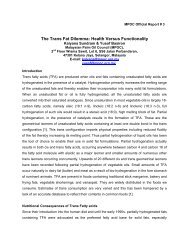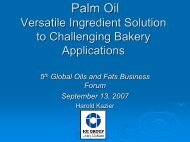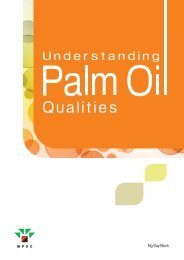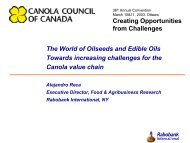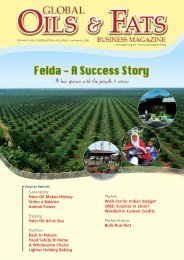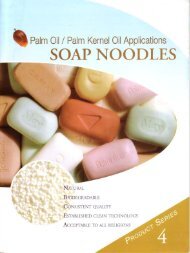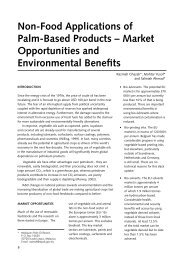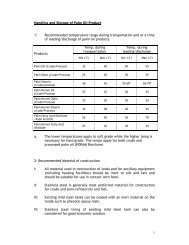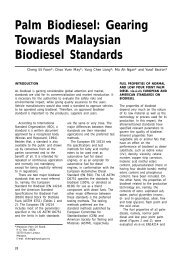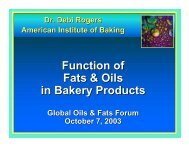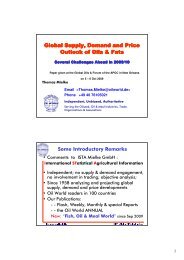The Changing World of Oleochemicals
The Changing World of Oleochemicals
The Changing World of Oleochemicals
Create successful ePaper yourself
Turn your PDF publications into a flip-book with our unique Google optimized e-Paper software.
<strong>The</strong> <strong>Changing</strong> <strong>World</strong> <strong>of</strong><br />
<strong>Oleochemicals</strong><br />
Wolfgang Rupilius* and Salmiah Ahmad**<br />
INTRODUCTION<br />
Never before in the history <strong>of</strong> oleochemicals have the changes been more<br />
dramatic than in the last 25 years. Before discussing these developments,<br />
I would like first to define the term oleochemicals and basic oleochemicals<br />
as used in this paper.<br />
DEFINITIONS<br />
<strong>Oleochemicals</strong> are generally<br />
chemical products derived from<br />
animal or vegetable triglycerides,<br />
even if they contain elements<br />
<strong>of</strong> petrochemical origin. Basic<br />
oleochemicals are fatty acids,<br />
fatty alcohols, methyl esters and<br />
glycerine (Figure 1).<br />
RAW MATERIALS FOR BASIC<br />
OLEOCHEMICALS<br />
<strong>The</strong> worldwide production and<br />
consumption <strong>of</strong> fats and oils are<br />
shown in Figure 2. Although only<br />
14% <strong>of</strong> the total production <strong>of</strong> fats<br />
and oils is used for oleochemicals,<br />
there are some selective<br />
Figure 2. <strong>World</strong>wide production and<br />
consumption <strong>of</strong> oils and fats in 2003<br />
(million tonnes).<br />
triglycerides, like coconut, palm<br />
kernel and high erucic rapeseed<br />
oil that are mostly so used (Figure<br />
3). In the future, the growth <strong>of</strong><br />
oleochemicals based on these raw<br />
materials may be limited by their<br />
availability, if the right corrective<br />
measures are not taken in time.<br />
MARKETS FOR BASIC<br />
OLEOCHEMICALS<br />
Figures 4, 5 and 6 show that basic<br />
oleochemicals are used in many<br />
different industries. Until a few<br />
years ago, methyl esters had only<br />
limited use as intermediates for<br />
the production <strong>of</strong> fatty alcohols.<br />
With the development <strong>of</strong> biodiesel<br />
in Europe, they have become<br />
by far the fastest growing basic<br />
oleochemicals.<br />
GLOBAL DEVELOPMENTS IN THE<br />
OLEOCHEMICALS INDUSTRY<br />
In this section, the most important<br />
developments that have affected<br />
the oleochemicals industry in the<br />
last 25 years will be discussed.<br />
ASEAN Growth<br />
<strong>The</strong> rapid growth in production<br />
<strong>of</strong> palm oil and palm kernel oil in<br />
ASEAN has made the development<br />
Figure 1. Basic oleochemicals.<br />
* Karl-Marx-Dam 99<br />
D-15526-Bad<br />
Saarow, Germany.<br />
E-mail: rupilius@aol.com<br />
** Malaysian Palm Oil Board<br />
P. O. Box 10620, 50720 Kuala Lumpur,<br />
Malaysia.<br />
Figure 3. Raw materials for oleochemical.<br />
see page 21<br />
15
<strong>The</strong> <strong>Changing</strong> <strong>World</strong> Of <strong>Oleochemicals</strong><br />
from page 15<br />
<strong>of</strong> the oleochemicals industry in<br />
this part <strong>of</strong> the world possible.<br />
ASEAN is constantly increasing<br />
its world market share <strong>of</strong> fatty<br />
acids and fatty alcohols (Figures<br />
7 and 8). Until 2003, the same<br />
phenomenon was observed with<br />
glycerine. This situation is now<br />
changing dramatically, since<br />
Europe is strongly increasing<br />
the production <strong>of</strong> glycerine,<br />
a co-product <strong>of</strong> the biodiesel<br />
manufacturing process.<br />
Exit <strong>of</strong> the Traditional Players<br />
Figure 4. Market for oleochemical - fatty acids.<br />
Figure 5. Market for oleochemical - fatty alcohols.<br />
Figure 6. Market for oleochemical - glycerine.<br />
Figure 9 shows that the<br />
prominent western producers <strong>of</strong><br />
basic oleochemicals are either<br />
selling or limiting their activities<br />
in this area. Henkel, Unilever<br />
and Petr<strong>of</strong>ina have sold all their<br />
oleochemicals activities. Procter<br />
& Gamble has closed or sold their<br />
fatty acid production plants in the<br />
USA, but continues to expand in<br />
fatty alcohols and glycerine. Akzo<br />
announced the intention to sell<br />
its fatty acid activities. From the<br />
traditional global companies which<br />
developed the oleochemicals<br />
industry more than 100 years ago,<br />
only Kao Corporation remains<br />
fully committed. <strong>The</strong> driving force<br />
behind this exit strategy is in large<br />
part the low pr<strong>of</strong>itability and the<br />
large capital required for world<br />
scale operations. Companies like<br />
Henkel, Unilever and Procter &<br />
Gamble are focusing their activities<br />
on consumer goods, a business<br />
which in general is less capital<br />
intensive and more pr<strong>of</strong>itable than<br />
basic oleochemicals.<br />
<strong>The</strong> fast development <strong>of</strong><br />
oleochemicals production capacity<br />
in ASEAN, with its very strong<br />
raw material integration, is the<br />
most important reason for the<br />
drastic reorganization taking<br />
place in the global oleochemicals<br />
21
Palm Oil Developments 44<br />
scenario. <strong>The</strong> increased pressure<br />
on margins, coming from modern<br />
large scale and highly productive<br />
manufacturing units in ASEAN,<br />
will continue to influence the<br />
global picture. It is only a matter<br />
<strong>of</strong> time until the dominant players<br />
in ASEAN look at the possibility<br />
<strong>of</strong> buying the existing production<br />
capacity in Europe and the United<br />
States.<br />
Consolidation <strong>of</strong> the Customer<br />
Basis<br />
As it is the case in most<br />
mature business, the customer<br />
basis for basic oleochemicals is<br />
also consolidating. Figure 10<br />
shows some examples <strong>of</strong> these<br />
developments. Smaller companies<br />
are acquired by multinational<br />
companies which, with their<br />
superior purchasing power and<br />
global purchasing organizations,<br />
are affecting negatively the<br />
pr<strong>of</strong>itability <strong>of</strong> the oleochemicals<br />
business. On the other hand,<br />
this development <strong>of</strong>fers the<br />
opportunity for ASEAN producers<br />
to enter into direct contact with<br />
their customers.<br />
Biodiesel<br />
8<br />
7<br />
6<br />
5<br />
4<br />
3<br />
2<br />
1<br />
0<br />
America Europe Asia Total<br />
Figure 7. Global fatty acid production capacity (million tonnes).<br />
2 500<br />
2 000<br />
1 500<br />
1 000<br />
500<br />
0<br />
America Europe Asia S. Africa Total<br />
1998<br />
2000<br />
2001<br />
2002<br />
2003<br />
2006f<br />
1994<br />
1998<br />
2002<br />
2006f<br />
Figure 8. Global fatty acid production capacity - synthetic and natural<br />
(‘000 tonnes).<br />
<strong>The</strong> European Union (EU),<br />
with its effort to support the<br />
local farming industry and the<br />
aim <strong>of</strong> developing environmental<br />
friendly fuels independent from<br />
petroleum, is heavily supporting<br />
the production <strong>of</strong> biodiesel based<br />
on canola oil methyl ester (low<br />
erucic rapeseed acid methyl<br />
ester). Since petroleum diesel<br />
has a tax <strong>of</strong> around € 0.60 per<br />
litre, biodiesel, which is not taxed<br />
at all, is becoming an attractive<br />
business (Figure 11). In 2005,<br />
the EU will produce more than<br />
Figure 9. <strong>The</strong> exit <strong>of</strong> traditional players.<br />
22
<strong>The</strong> <strong>Changing</strong> <strong>World</strong> Of <strong>Oleochemicals</strong><br />
2 million tonnes <strong>of</strong> biodiesel in<br />
around 50 production units. <strong>The</strong><br />
smallest plants produce only a<br />
few thousand tonnes, the largest<br />
around 200 000 t per year.<br />
While in the past there<br />
were few incentives to develop<br />
improved processes for the<br />
production <strong>of</strong> methyl esters, new<br />
technologies are being developed<br />
today to satisfy the demands for<br />
environmental friendly biodiesel<br />
plants. <strong>The</strong> process, described<br />
in Figure 12 and used in several<br />
large biodiesel plants in Europe,<br />
produces only biodiesel, glycerine<br />
and powdered potassium sulphate<br />
which is sold as fertilizer.<br />
<strong>The</strong> only advantage that<br />
100% biodiesel made from<br />
canola oil <strong>of</strong>fers as fuel is that it<br />
is CO 2 neutral (Figure 13). In the<br />
meantime, most <strong>of</strong> the biodiesel<br />
produced is added to petroleum<br />
diesel (up to a maximum <strong>of</strong> 5%)<br />
by the large petroleum companies.<br />
<strong>The</strong> goal <strong>of</strong> EU is to reduce the tax<br />
exemption for biodiesel in a few<br />
years. <strong>The</strong> large budget deficit <strong>of</strong><br />
Germany and France will probably<br />
also place expensive environmental<br />
projects on lower priority.<br />
<strong>The</strong> rapid expansion <strong>of</strong><br />
biodiesel is affecting negatively<br />
the overall pr<strong>of</strong>itability <strong>of</strong><br />
oleochemicals, since it has led to a<br />
dramatic reduction in the glycerine<br />
margin.<br />
Availability <strong>of</strong> Manufacturing<br />
Technology<br />
With the development <strong>of</strong><br />
the oleochemicals industry in<br />
ASEAN, specialized engineering<br />
companies were able to finance<br />
the development <strong>of</strong> competitive<br />
manufacturing technology, which<br />
originally was only available to the<br />
pioneer companies in the USA,<br />
Europe and Japan. In some cases,<br />
the technology available through<br />
the engineering companies today<br />
is superior to the technology<br />
practiced by the traditional<br />
industry leaders. A typical case<br />
is the fatty alcohol technology<br />
developed by Lurgi (Figure 14).<br />
While in the past in general<br />
there was only one supplier<br />
<strong>of</strong> technology for a specific<br />
process, today there is intensive<br />
competition between different<br />
engineering companies. An<br />
example is fatty alcohols where<br />
Lurgi and Davy are <strong>of</strong>fering two<br />
different technologies for their<br />
production (Figure 15). This<br />
Figure 10. Consolidation <strong>of</strong> the customer.<br />
Figure 11. <strong>The</strong> success <strong>of</strong> biodiesel in Europe.<br />
competition will guarantee that in<br />
the future there will be continuous<br />
improvement in the technology.<br />
<strong>The</strong> situation in methyl esters<br />
production is very similar, where<br />
due to the rapid expansion <strong>of</strong><br />
biodiesel; several companies are<br />
<strong>of</strong>fering efficient transesterification<br />
technology.<br />
Figure 16 shows the different<br />
technologies available for the<br />
production <strong>of</strong> synthetic alcohols<br />
which in certain markets, are<br />
competing with natural alcohols.<br />
<strong>The</strong> only synthetic alcohols<br />
identical to natural alcohols are<br />
those made from ethylene and<br />
aluminium alkyls by the Ziegler<br />
technologies. Since this process<br />
23
Palm Oil Developments 44<br />
Crude<br />
Triglycerides<br />
Refined<br />
Triglycerides<br />
Methyl Ester<br />
Fertilizer<br />
Biodiesel<br />
Figure 12. Environment friendly methyl ester process for biodiesel.<br />
is expensive and the intermediate<br />
aluminium alkyls difficult to<br />
handle, it is highly unlikely that<br />
new capacity will be built on this<br />
basis.<br />
5%-10% less performance than<br />
petroleum diesel<br />
Preference for Vegetable Oils<br />
Over Tallow<br />
Due to the BSE situation in<br />
Europe, many uses <strong>of</strong> tallow<br />
have been replaced by vegetable<br />
oils. Manufacturers <strong>of</strong> tallow<br />
fatty acids started to produce<br />
vegetable tallow fatty acid from<br />
palm oil or vegetable oleic fatty<br />
acid from palm kernel, coconut<br />
or canola oil. Although tallow is<br />
slowly recovering from its negative<br />
image, it is unlikely that it will<br />
fully regain the position it had in<br />
specific markets, like personal care.<br />
Figure 13. Used properties <strong>of</strong><br />
biodiesel 100% canola methyl ester.<br />
Figure 14. Development <strong>of</strong> fatty<br />
alcohol technology (Lurgi).<br />
Figure 15. Technologies for the production <strong>of</strong> fatty alcohols.<br />
SUPPLY AND DEMAND FOR<br />
BASIC OLEOCHEMICALS<br />
<strong>The</strong> global developments described<br />
are having important impacts on<br />
the supply and demand <strong>of</strong> basic<br />
oleochemicals.<br />
Fatty Acids<br />
Different sources estimate the<br />
global capacity utilization <strong>of</strong> fatty<br />
acid plants at 70% to 75%. Since<br />
Figure 16. Technologies for production <strong>of</strong> synthetic alcohols.<br />
24
<strong>The</strong> <strong>Changing</strong> <strong>World</strong> Of <strong>Oleochemicals</strong><br />
several new plants are coming<br />
on stream in the next few years<br />
in Malaysia, Indonesia and China<br />
with a total capacity <strong>of</strong> nearly 500<br />
000 t per year, the situation will<br />
not improve. This excess capacity<br />
is, as expected, having a negative<br />
impact on the pr<strong>of</strong>itability <strong>of</strong> fatty<br />
acids (Figure 17).<br />
Fatty Alcohols<br />
<strong>The</strong> supply and demand<br />
situation for fatty alcohols is much<br />
less transparent than that for fatty<br />
acids, since long chain alcohols are<br />
also made from petrochemicals<br />
and coal (Figure 18). <strong>The</strong><br />
synthetic alcohols manufactured<br />
via Ziegler technology are identical<br />
to natural alcohols, and can<br />
replace them in all applications.<br />
Those manufactured via<br />
hydr<strong>of</strong>ormylation technology have<br />
a variable degree <strong>of</strong> branching<br />
depending on the catalysts and<br />
olefins used, and compete with<br />
natural fatty alcohols in some <strong>of</strong><br />
the largest markets (for example,<br />
detergents, dishwashing liquids,<br />
etc.).<br />
In 2003, the low pr<strong>of</strong>itability<br />
<strong>of</strong> fatty alcohols, a result <strong>of</strong> excess<br />
capacity, forced several producers<br />
in Europe, the USA and Japan to<br />
close inefficient manufacturing<br />
units. At this moment, it is<br />
estimated that the worldwide<br />
supply and demand situation is<br />
in equilibrium. Since there are<br />
several new fatty alcohol projects<br />
under planning or construction<br />
(with a total capacity <strong>of</strong> nearly<br />
400 000 t per year), it is estimated<br />
that from the beginning <strong>of</strong> 2006<br />
there will be again excess capacity.<br />
It is interesting to note that<br />
while natural fatty alcohols nearly<br />
disappeared from the market<br />
before the petroleum crisis in<br />
1974, they have since continuously<br />
Figure 17. Impact <strong>of</strong> overcapacity on lauric fatty raw material margin in Europe<br />
(Euro per tonne).<br />
regained market share at the<br />
expense <strong>of</strong> petrochemically made<br />
alcohols. At this moment, it is still<br />
too early to forecast the future <strong>of</strong><br />
synthetic alcohols produced from<br />
coal in South Africa.<br />
Glycerine<br />
2 000<br />
1 800<br />
1 600<br />
1 400<br />
1 200<br />
1 000<br />
800<br />
600<br />
400<br />
200<br />
0<br />
Figure 18. Natural fatty alcohols are growing faster than synthetic alcohol<br />
(in ‘000 t).<br />
<strong>The</strong> world <strong>of</strong> glycerine was<br />
quite in order until biodiesel came<br />
about. If the political environment<br />
in Europe does not change, we can<br />
expect up to 500-700 thousand<br />
tonnes <strong>of</strong> additional glycerine<br />
per year from the biodiesel plants<br />
within a few years. <strong>The</strong>re will<br />
be an outlet for this additional<br />
glycerine, but at a low price<br />
(Figure 19). Experts expect a<br />
further decline in the price, in spite<br />
<strong>of</strong> the fact that the petrochemically<br />
made polyols are already more<br />
expensive than glycerine (for<br />
example, ethylene glycol is at<br />
around € 1000 per tonne).<br />
This development has had a<br />
pr<strong>of</strong>ound influence on the overall<br />
pr<strong>of</strong>itability <strong>of</strong> oleochemicals. A<br />
long-term low price <strong>of</strong> glycerine<br />
can also affect other oleochemical<br />
processes, since its recovery<br />
and purification may not be<br />
economically justified. <strong>The</strong>re<br />
are already some oleochemical<br />
derivatives in the market, like<br />
alkanolamides or betaines, which<br />
contain glycerine and made<br />
directly from triglycerides without<br />
going through the fatty acid or<br />
methyl ester route. Cognis has<br />
also developed a technology<br />
to manufacture fatty alcohols<br />
through direct hydrogenation <strong>of</strong><br />
triglycerides, in which glycerine is<br />
transformed to propylene glycol.<br />
<strong>The</strong> search for new uses<br />
<strong>of</strong> glycerine is one <strong>of</strong> the most<br />
urgent areas <strong>of</strong> innovation in the<br />
oleochemicals industry.<br />
25
Palm Oil Developments 44<br />
INVESTMENT IN WORLD SCALE<br />
OLEOCHEMICALS PLANTS<br />
Modern oleochemicals plants are<br />
very capital intensive, no matter<br />
where they are built. While in the<br />
early 1980s, the oleochemicals<br />
plants built in ASEAN were<br />
relatively small when compared<br />
with the plants in Europe or the<br />
USA, today the largest and most<br />
modern plants are being erected<br />
in Malaysia and Indonesia. This<br />
modern plants and excellent<br />
raw material integration, gives<br />
producers in ASEAN an important<br />
competitive advantage over their<br />
competitors overseas.<br />
Figure 20 shows some<br />
examples <strong>of</strong> the scale <strong>of</strong><br />
investment made in the last 15<br />
years. As an approximation, it<br />
can be said that for a capacity <strong>of</strong><br />
100 000 t per year <strong>of</strong> fatty acid/<br />
glycerine to be made from fats<br />
and oils (including infrastructure),<br />
an investment <strong>of</strong> around USD<br />
100 million is required. Due to<br />
increased competition between the<br />
engineering companies (especially<br />
in the area <strong>of</strong> methyl ester,<br />
glycerine and fatty alcohols), there<br />
is a tendency for the investment<br />
costs to fall.<br />
Investments in basic<br />
oleochemicals in ASEAN are very<br />
<strong>of</strong>ten by palm oil plantations,<br />
either alone or with a jointventure<br />
partner, who brings in<br />
the technology and a marketing<br />
and sales organization. <strong>The</strong> aim<br />
for the plantation is to have an<br />
additional market for its palm and<br />
palm kernel oils buffered from<br />
the price fluctuations in the food<br />
market. For example, a plantation<br />
which produces around 500 000 t<br />
<strong>of</strong> oil per year, by investing around<br />
USD 100 million in fatty acids and<br />
glycerine, will still be selling<br />
400 000 t per year <strong>of</strong> oil in the<br />
2 000<br />
1 000<br />
800<br />
600<br />
400<br />
200<br />
100 000<br />
60 000<br />
60 000<br />
0<br />
Figure 19. Impact <strong>of</strong> overcapacity on the selling price <strong>of</strong> glycerine (in Euro t -1 ).<br />
10 000 t yr -1<br />
Figure 20. Estimated investment cost for world scale plants for producing basic<br />
oleochemicals.<br />
food market and 100 000 t <strong>of</strong><br />
oleochemicals.<br />
ALTERNATIVE OLEOCHEMICALS<br />
STRATEGIES FOR ASEAN<br />
In view <strong>of</strong> the existing<br />
overcapacity, the low pr<strong>of</strong>itability<br />
and the large investments required<br />
for basic oleochemicals (Figure 21),<br />
other strategies for growth should<br />
be considered.<br />
For companies producing fatty<br />
acids, fatty alcohols and glycerine,<br />
the most logical growth strategy<br />
is to integrate forward into more<br />
(hydrogenation, distillation, fractionation,<br />
refining)<br />
specialized derivatives. This route<br />
is already being taken by several<br />
companies, and the production <strong>of</strong><br />
esters is expanding rapidly in the<br />
region.<br />
<strong>The</strong> main hindrance for the<br />
growth <strong>of</strong> specialties from basic<br />
oleochemicals in ASEAN is the fact<br />
that the manufacturing know-how<br />
is generally not in the hands <strong>of</strong> the<br />
engineering companies which build<br />
the plants. <strong>The</strong>se specialties are,<br />
generally, from the tonnage point<br />
<strong>of</strong> view, smaller products made in<br />
multipurpose batch reactors. <strong>The</strong>ir<br />
manufacture is, even in modern<br />
26
<strong>The</strong> <strong>Changing</strong> <strong>World</strong> Of <strong>Oleochemicals</strong><br />
manufacturing units, not totally<br />
computerized and special attention<br />
and intervention from experienced<br />
personnel is required during their<br />
production processes. Additionally,<br />
these products very <strong>of</strong>ten cannot<br />
just be sold by specifications,<br />
like basic oleochemicals, and a<br />
specialized applied research and<br />
marketing organization is needed.<br />
In view <strong>of</strong> the high price <strong>of</strong><br />
lauric oils, more focus should be<br />
given to the use <strong>of</strong> palm oil as raw<br />
material for oleochemicals.<br />
A few examples <strong>of</strong> alternative<br />
oleochemicals strategies for ASEAN<br />
will be discussed in the following<br />
section.<br />
Methyl Ester Sulphonate<br />
<strong>The</strong> production <strong>of</strong> methyl<br />
ester sulphonate (MES) from<br />
palm stearin (Figure 22) <strong>of</strong>fers<br />
the possibility to replace alkyl<br />
benzene sulphonate (worldwide<br />
production <strong>of</strong> over 3 million tonnes<br />
per year), the workhorse <strong>of</strong> the<br />
detergent industry. With palm<br />
stearin prices below USD 400 per<br />
tonne, it should not be a problem<br />
to compete with alkyl benzene at<br />
more than USD 1000 per tonne.<br />
<strong>The</strong> economic potential <strong>of</strong> this<br />
product class can be seen by the<br />
fact that in 2003, an 80 000 t<br />
methyl ester sulphonate plant was<br />
built in Texas, USA, the last place<br />
one would expect a petrochemical<br />
product to be replaced by an<br />
oleochemical product. <strong>The</strong> fact<br />
that MES is produced as a waterfree<br />
powdered or flaked solid<br />
makes its transport over long<br />
distances possible. <strong>The</strong>refore, a<br />
large scale production unit in a<br />
region where the raw materials -<br />
palm stearin, methanol, hydrogen,<br />
sulphur, hydrogen peroxide and<br />
Figure 21. Global situation <strong>of</strong> basic oleochemicals.<br />
sodium hydroxide are available,<br />
will not only satisfy the needs <strong>of</strong><br />
the local markets, but also allow<br />
for export overseas.<br />
Another attractive raw material<br />
for the production <strong>of</strong> MES can be<br />
the C16 methyl ester, a by-product<br />
from the production <strong>of</strong> biodiesel <strong>of</strong><br />
the quality required for European<br />
climatic conditions.<br />
Raw Materials for Polymers<br />
Even without investing in<br />
large scale plants to produce<br />
basic oleochemicals, it is possible<br />
to produce specialties directly<br />
from palm oil (Figure 23). It is<br />
possible to produce a broad range<br />
<strong>of</strong> chemicals as intermediates<br />
for the polymer industry from<br />
epoxidized palm oil. A typical<br />
example is polyols, by reacting<br />
epoxidized palm oil with ethylene<br />
or propylene glycol. <strong>The</strong> palm oil<br />
polyols obtained can be used to<br />
replace petrochemical polyols in<br />
the manufacture <strong>of</strong> polyurethanes.<br />
<strong>The</strong> total world market for polyols<br />
for polyurethanes is in the range<br />
<strong>of</strong> 5 million tonnes per year, and<br />
growing at around 5% per year.<br />
In Europe and the USA, this<br />
class <strong>of</strong> polyols, based on soya oil,<br />
is already being used in large scale<br />
in the polyurethane industry.<br />
Figure 22. Methyl ester sulphonate from palm stearin.<br />
27
Palm Oil Developments 44<br />
<strong>The</strong> epoxidized palm oil itself<br />
can be used as a plasticizer for<br />
PVC or as extender in rubber.<br />
Nonionic Surfactants from Methyl<br />
Esters<br />
Methyl esters <strong>of</strong> diverse<br />
chain lengths are becoming<br />
readily available materials since<br />
they are produced in large scale<br />
and used as biodiesel. Since<br />
the biodiesel market is, for the<br />
moment, strongly predicated on<br />
tax incentives, it is reasonable<br />
to develop additional uses for<br />
methyl esters. A relatively young<br />
technology is their ethoxylation.<br />
(Figure 24). <strong>The</strong> products<br />
differentiate themselves from<br />
fatty alcohol ethoxylates in<br />
their foaming behaviour and<br />
solubility. <strong>The</strong>y can be produced<br />
in conventional ethoxylation units<br />
using special catalysts, and their<br />
total production cost should be<br />
lower than that for fatty alcohol<br />
ethoxylates. Especially, the<br />
large price difference between<br />
unsaturated fatty alcohols<br />
Figure 23. Raw material for polymers<br />
from palm oil.<br />
and unsaturated methyl esters<br />
should make this technology<br />
economically very attractive. <strong>The</strong><br />
only limitations for the use <strong>of</strong><br />
methyl ester ethoxylates is the<br />
reduced hydrolytic stability <strong>of</strong> the<br />
ester bond. On the other hand,<br />
several surfactants with similar<br />
ester bonds, like esterquats or<br />
MES, have found large markets in<br />
commercial detergents<br />
CONCLUSION<br />
Figure 24. Nonionic surfactants through ethoxylation.<br />
<strong>The</strong> global industry <strong>of</strong> basic<br />
oleochemicals is changing at a<br />
dramatic pace. While in Europe,<br />
the United States and Japan, the<br />
production <strong>of</strong> fatty acids and fatty<br />
alcohols remains constant or is<br />
even decreasing, ASEAN, with<br />
its strong raw material base, is<br />
expanding with world scale plants<br />
and increasing rapidly its global<br />
market share. In glycerine, even<br />
stronger growth is taking place<br />
in Europe, where large amounts<br />
are produced as co-product in<br />
biodiesel production.<br />
<strong>The</strong> future <strong>of</strong> biodiesel (canola<br />
methyl esters) will depend strongly<br />
on the fiscal policies <strong>of</strong> the EU.<br />
With growing fiscal deficits <strong>of</strong><br />
most <strong>of</strong> the EU countries, it is very<br />
likely that its tax exemption will be<br />
reduced step by step.<br />
It can be expected in ASEAN,<br />
that the existing producers <strong>of</strong><br />
basic oleochemicals will gradually<br />
direct their future growth to the<br />
development <strong>of</strong> derivates <strong>of</strong> fatty<br />
acids, fatty alcohols, methyl esters<br />
and glycerine.<br />
New entrants into the industry<br />
should consider other strategies<br />
than the production <strong>of</strong> basic<br />
oleochemicals. Opportunities for<br />
the development <strong>of</strong> products from<br />
palm and palm kernel oils, without<br />
going through basic oleochemicals,<br />
should be carefully evaluated.<br />
28



